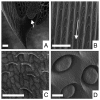The carnivorous syndrome in Nepenthes pitcher plants: current state of knowledge and potential future directions
- PMID: 21135573
- PMCID: PMC3001552
- DOI: 10.4161/psb.5.6.11238
The carnivorous syndrome in Nepenthes pitcher plants: current state of knowledge and potential future directions
Abstract
Nepenthes is the largest genus of pitcher plants, with its centre of diversity in SE Asia. The plants grow in substrates that are deficient in N and offset this deficiency by trapping animal prey, primarily arthropods. Recent research has provided new insights into the function of the pitchers, particularly with regard to prey tapping and retention. Species examined to date use combinations of wettable peristomes, wax layers and viscoelastic fluid to trap and retain prey. In many respects, this has redefined our understanding of the functioning of Nepenthes pitchers. In addition, recent research has shown that several Nepenthes species target specific groups of prey animals, or are even evolving away from a strictly carnivorous mode of operation. Future research into nutrient sequestration strategies and mechanisms of prey attraction would no doubt further enhance our knowledge of the ecology of this remarkable genus.
Figures

References
-
- Ellison AM, Gotelli NJ. Energetics and the evolution of carnivorous plants-Darwin's ‘most wonderful plants in the world’. J Exp Bot. 2009;60:19–42. - PubMed
-
- Jebb MHP, Cheek M. A skeletal revision of Nepenthes (Nepenthaceae) Blumea. 1997;42:1–106.
-
- Clarke CM. Nepenthes of Borneo. Kota Kinabalu: Natural History Publications; 1997.
-
- Clarke CM. Nepenthes of Sumatra & Peninsular Malaysia. Kota Kinabalu: Natural History Publications; 2001.
-
- Juniper BE, Robins RJ, Joel D. The Carnivorous Plants. London: Academic Press; 1989.
Publication types
MeSH terms
LinkOut - more resources
Full Text Sources
Molecular Biology Databases
